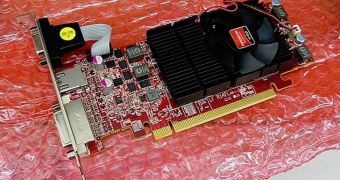Just yesterday (August 2014), we reported on the existence of a new graphics card from Advanced Micro Devices, one that blurs the line between low-end and mainstream performance capability. It is called Radeon R7 250XE and has now been pictured.
Not that the photo is the most important part of this report. Sure, it's nice to see just what the board looks like, but the specifications are a bit more relevant.
Admittedly, we already knew that GDDR5 VRAM memory would be used, and that its clock speed was of 4.5 GHz. Well beyond the ability of DDR3 memory normally used in entry-level video adapters.
Then again, the “normal” Radeon R7 250X isn't exactly a pushover either. Even though it's marketed as an entry-level card (although not to the same level as, say, the GT 240), it's too strong for that in practice (Cape Verde XT GPU with 640 stream processors, 1 GHz clock, 2 GB of GDDR5 VRAM at 4.5 GHz and controlled via 128-bit interface).
Back to the R7 250XE, the E in the name (which stands for expert) is kind of a strange addition, since the adapter is actually a lot weaker than the R7 250X.
Oh sure, it still has GDDR5 VRAM at 4.5 GHz, but only 1 GB of it (this has finally been confirmed, more or less).
Also, the Cape Verde GPU (graphics processing unit) runs at 860 MHz. This is the biggest revelation yet. At least the Stream Processor count is the same (640). That said, the video board also boasts a memory interface of 128 bits.
All in all, this is a mid-range video card advertised as low-end simply because true entry-level boards can't be sold anymore, as all CPUs and APUs from Intel and AMD have integrated GPUs that offer everything such things could.
The AMD Radeon R7 250XE is likely to run any game just fine and will probably have a price of around $60 - $70 / €45.3 - €70. It means that it will have NVIDIA's GeForce GTX 730 and 740 as direct competitors.
It's not clear how good the timing of this product is, since AMD is about to launch the Tonga-Based Radeon R9 285, or so the web has assumed. Then again, that's a much stronger card, so there won't be any overlap. It's like AMD hopes that the R7 250XE will ride the momentum that the R9 285 will cause. If so, it remains to be seen if it works.

 14 DAY TRIAL //
14 DAY TRIAL //